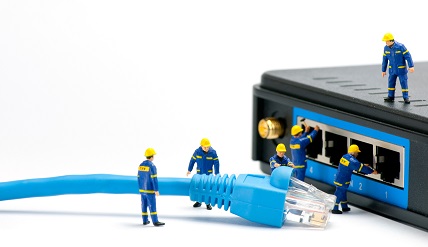 With the whole world and everything in it being online these days, becoming disconnected from the internet is just about the worst thing that can happen to a person. Whether you are accessing the internet for business or pleasure, few things can make our blood boil like seeing the little yellow warning triangle pop up over our computer’s connection state.
With the whole world and everything in it being online these days, becoming disconnected from the internet is just about the worst thing that can happen to a person. Whether you are accessing the internet for business or pleasure, few things can make our blood boil like seeing the little yellow warning triangle pop up over our computer’s connection state.
In case you aren’t aware, there’s a grouping of devices known collectively as network interface controllers (NICs). NIC refers to any hardware component which make it possible for your device to communicate via the internet – or any network of computers. Every time you stream a movie, visit a webpage, download a file, or send an internal email using your PC it’s NICs which are making it possible.
NICs can take the form of components inside your computer such as your LAN card, or external elements like an Ethernet cable or router.
Therefore, if an NIC breaks down you don’t get to connect to your networks anymore. However, as with any technology there are symptoms which can clue you in as to when your NIC is on the way out. Learning how to spot these clues means you can deal with any issues quickly, and keep your downtime to a minimum.
Intermittent Connection
One of the first things which should alert you to the imminent onset of NIC issues is an intermittent network connection. If you notice your connection keeps dropping out for periods of time – anything from a few seconds to hours – you probably have a NIC issue.
The first step to take to diagnose the problem is to check your internet router. Most ISP supplied routers will have four lights on them – power, broadband, internet, Wi-Fi. If everything is fine the power and broadband lights should be a steady green (the colour varies between routers but green is the most common), and the internet and Wi-Fi should be flickering (the flickering means information is being sent from or received by the router.
When the connection drops out, look at the router and see if any of the lights are behaving differently.
· A red or unilluminated power light may indicate an issue with the electricity supply to the router. Check the power lead and/or power socket.
· A flashing or different colour broadband light indicates the router is trying and/or failing to synchronise.
· A steady flashing or different colour internet light indicates there is an issue with the PPP credentials your router uses to log on to your ISP’s network.
· A steady flashing or different colour Wi-Fi light indicates an issue with the router’s Wi-Fi transmitter.
Bear in the symptoms described above are the way most commonly used routers behave and you should check your own router’s instruction manual to clarify how it indicates various states. If you are experiencing any of the above issues then you have a problem with either your router or internet service and should contact your ISP for advice on how to resolve it.
However, if everything seems to be working fine as far as the router is concerned, then you need to work back towards your computer.
Connection Types
Does your device connect to your network via Wi-Fi or an Ethernet cable?
If it connects via Ethernet, try a different cable or see if there is a loose connection on either your device, or the router. However, if you connect via Wi-Fi, there could be a multitude of things interfering with the signal.
· Stereo equipment
· Games consoles
· HD televisions
· Road works
· Trains
· Traffic
· Street lights
· Car immobilisers
· And more
Essentially, anything electrical has the potential to interfere with a Wi-Fi signal. Look for any correlation between any of these factors and your loss of connection. The distance a Wi-Fi signal must travel, or what it must pass through (walls etc.) can also have an effect, so see if the problem still exists when you’re in the same room as the router.
If you suspect a home or work environment issue may be the source of your problem, but you have been unable to locate it yourself, your ISP may be able to arrange for an engineer to visit to try and make a diagnosis.
Ping Test
The next thing to do is carry out a ping test to make sure your LAN card is working properly. A ping test sends a packet of data, and times in milliseconds how long it takes to get a response.
· Access the command prompt
· Type “ping 127.0.0.1” without quotes and press Enter.
· Your computer will start to ping the LAN card by sending packets.
· The results will then be displayed, showing if the LAN card is responding to the packets that were sent.
· If the results show, “Packets: Sent=4, Receive=4, Lost=0,” this means the LAN card is working.
· However, if the results show, “Packets: Sent=4, Receive=0, Lost=4,” or similar, it means your LAN card is faulty and may need to be replaced.
Depending on your own level of IT skill, or if you are still unclear as to the source of the issue, you may want to take your PC to an IT technician. However, follow the above steps and you may just save yourself a trip, money, waiting on hold with your ISP, and too much time offline.
If you need powerful server monitoring for your business. Please get in touch today.